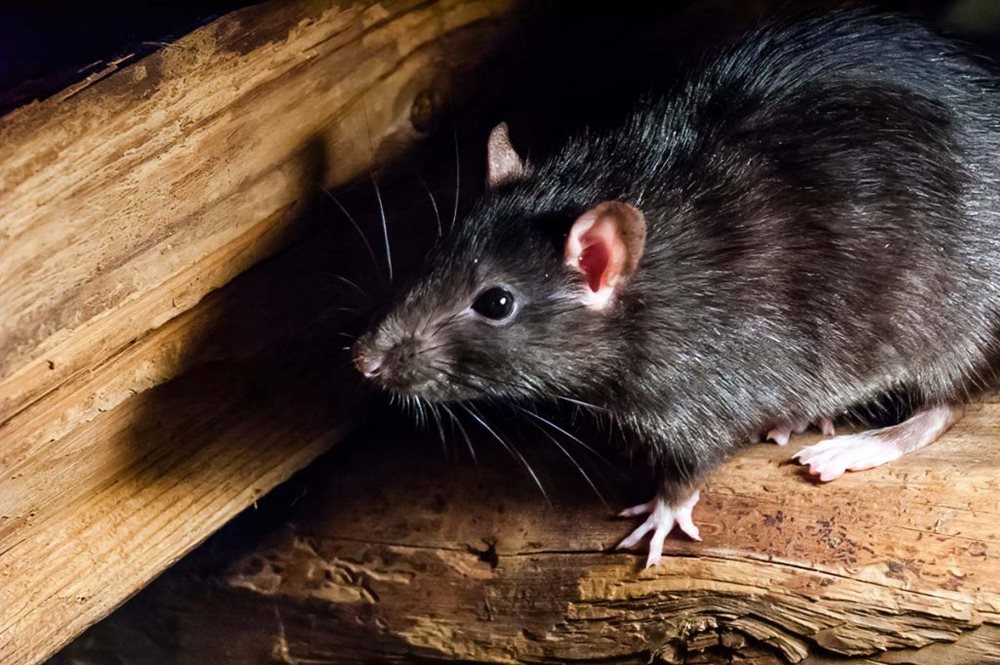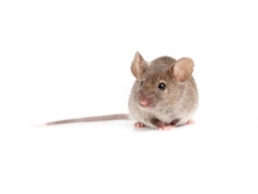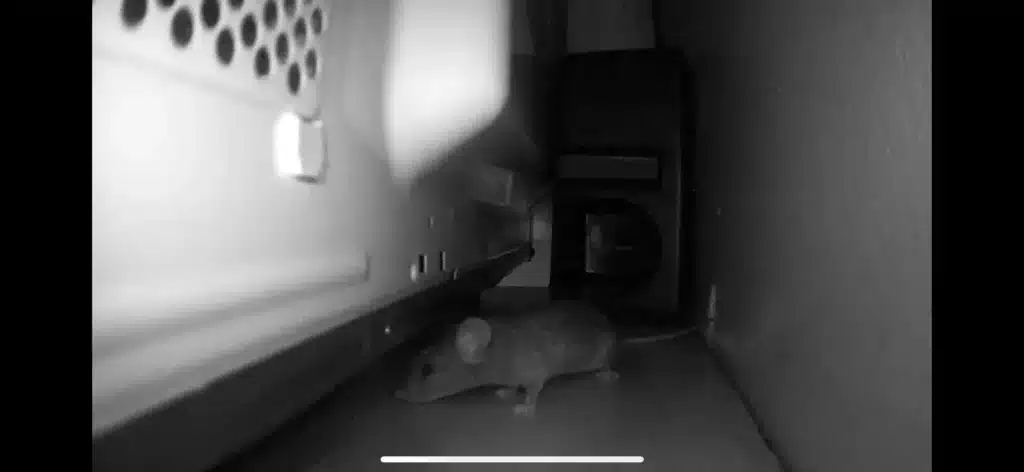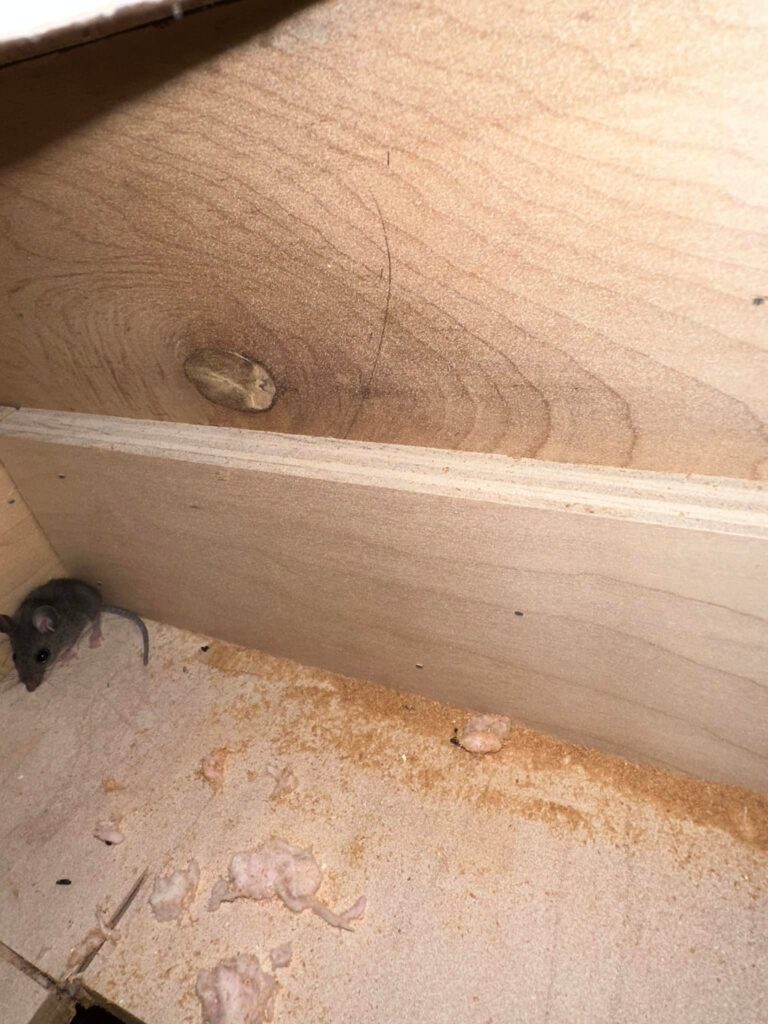

Dealing with rodents inside your walls is a complex issue that requires professional expertise. They can squeeze through tiny openings, making detection and removal challenging.
At Critter Control, we understand that a rodent infestation inside your walls is more than just an annoyance—it’s a serious problem that can compromise your home and your health.
With this in mind, you’ll want to discover:
- How to get rid of rodents in walls.
- The signs of a rodent infestation.
- How to distinguish between mice and rats in your walls.
How Do Rodents Get in Walls?

Rodents have lived alongside humans for thousands of years, and they’ve learned to largely rely on humans for food, water, and shelter. This is why they go to extreme lengths to enter homes, squeezing through cracks as small as a quarter of an inch. Rodents in the attic or basement will use wall voids to travel from their nest to your kitchen, where they can raid your pantry nightly.
Their small size, flexibility, ability to climb, and ability to chew through almost anything make it easy for them to take advantage of weak spots in your home. Small gaps in doors, around pipes, and aging roofing are some of the entry points rodents use to enter your home. Once inside, their sharp teeth enable them to gnaw through wood to get into the walls, where they find warmth and safety.
Many homeowners find rodents in their walls very annoying. They tear insulation and build nests, bringing ticks, fleas, and mites with them.
Signs of Rodents Inside Wall
Rodents are household pests that leave you with clear signs of their presence. Since they create significant and costly damage to homes and are a health threat, these signs should prompt you to call Critter Control before the infestation grows too large.
Droppings
Both mice and rats leave droppings as they travel. Mice vs. rat droppings can be determined mainly by size. Rat droppings are larger and more blunt than pointed at the ends. Mice defecate constantly and leave small rice-like droppings in a trail along their routes. Rats defecate less frequently. Rats can also leave droppings in clusters.
Scurrying or Squeaking Sounds at Night
Mice and rats are nocturnal. If you have rodents in your walls, you will hear rubbing and scratching at night as they move around. You will also hear them gnawing on wood and drywall, causing possible structural damage. You may also hear rodent squeaking as they communicate with one another.
Gnaw Marks on Wood
The front incisor teeth of rodents grow throughout their lives at a rate of about four to five inches per year. They need to chew constantly to maintain their teeth at a manageable level, or they would pierce themselves. Rodents within your walls will chew on beams and rafters. They will also chew through walls to create pathways from their nests to pantries, cabinets, and counters to find food and water.
Chew Marks on Food Packaging

Once in your cabinets and pantry and on your countertops, rodents can easily chew through cardboard food boxes and plastic bags. You’ll be able to tell that it is the work of rodents as you’ll see the droppings they leave behind.
Signs of Mice in Walls
Mainly because of the difference in size, mice sounds in your walls are softer than rat sounds. Mice are more curious than rats and will explore their territory more than rats. Other signs that are specific to mice include:
- Oblong droppings 1/8 to a 1/4 inch long
- Nests close to food source behind appliances or under cupboards
- Musky smell
Signs of Rats in Walls
Rats are larger and heavier than mice, so their sounds in your walls will be louder. They will make louder thumping sounds as opposed to the lighter tapping of mice. Signs that are more specific to rats include:
- Droppings with a rounded edge at 3/8ths of a inch long
- Nests typically in attic or under the house in crawl spaces or basements
- Rub marks along baseboards
Problems with Rodents in the Walls

Whether you find evidence of rats or mice, both rodents should be considered a big problem. Rodents in walls can spread diseases, contaminate your house, and cause costly destruction.
Structural Damage
Mice and rats, like all rodents, have constantly growing incisors, which means they’re always gnawing to keep them trimmed. Your walls provide the perfect material for this. This destructive behavior can lead to:
- Chewed Electrical Wires: This is one of the most dangerous problems. Rodents gnawing on electrical wires can strip away insulation, creating exposed wires that are a significant fire hazard. Many house fires are attributed to rodent activity.
- Damaged Insulation: Rodents love to burrow into insulation to create nests. As they shred and tunnel through it, your insulation loses its effectiveness, leading to higher energy bills and reduced comfort. This also makes the insulation a breeding ground for bacteria and odors from their waste.
- Weakened Wood and Drywall: They’ll gnaw through wooden beams, drywall, and other building materials to create pathways and expand their living space. Over time, this can compromise the structural integrity of your home, leading to costly repairs.
- Contaminated HVAC Systems: Rodents often travel through ductwork, building nests and leaving droppings and urine. This can spread contaminants throughout your home and even cause mechanical failures in your heating and cooling systems.
Health Risks
A rodent infestation poses significant health risks to you and your family.
- Disease Transmission: Rodents carry numerous diseases, including Hantavirus, Leptospirosis, Salmonellosis, and Rat-Bite Fever. These can be transmitted through direct contact with rodents, their bites, or by breathing in airborne particles from their urine, droppings, or saliva. When disturbed, the dried waste can become aerosolized, leading to serious respiratory illnesses.
- Allergens and Asthma Triggers: Rodent dander, urine, and droppings can trigger allergies and asthma symptoms, especially in sensitive individuals.
- Parasites: Rodents are often carriers of fleas, ticks, and mites. These parasites can then infest your home and transmit their own set of diseases to both humans and pets, such as Lyme disease or Murine typhus.
How to Identify Rat vs Mouse Droppings
Unsanitary conditions develop soon after rodents move into the walls. The pests’ droppings pile up quickly, creating a musty smell that can linger for weeks.
- Rat Droppings: Typically dark brown or black, rat droppings are tapered and measure about 1/2 to 3/4 inch long, resembling grains of rice with blunt ends. They are usually found in concentrated areas, indicating high activity. Immediate action is necessary if you find these droppings to prevent an infestation.
- Mouse Droppings: Smaller than rat droppings, mouse droppings are about 1/4 inch long with pointed ends and are often scattered. If you find small droppings spread around your house, you likely have a mouse problem.
Homeowners who try to clean up rodent waste should take extreme caution, as contact can lead to Hantavirus, leptospirosis, and other illnesses.
Sounds
During the night, rodents in wall voids annoy residents with the rubbing and scratching sounds they make while moving around.
They also create loud noises while gnawing wood and drywall, causing unease and possible structural damage. Residents may hear squeaking as well when rodents in the walls communicate with each other.
Odor and Contamination
- Foul Odors: Rodent urine has a distinct, musky, ammonia-like smell that can permeate your walls and home. As droppings accumulate, they also create a lingering, unpleasant odor. If a rodent dies within the wall void, the decaying carcass will produce an extremely strong and persistent odor that can last for weeks.
- Food Contamination: Rodents are constantly seeking food. They’ll chew through food packaging and contaminate stored food items with their droppings, urine, and hair, rendering them unsafe for consumption.
Migration
Mice and rats will stay close to their nest, and wall voids provide safe ways to travel through your entire house. Rodents in the walls often uses structural voids to move from attics or basements into other areas like kitchens and bedrooms. You will hear them scurrying back and forth inside the walls. This is when residents are at the greatest risk from the pests’ waste and parasites.
How We Get Rid of Rodents in Your Wall

Our four-step process identifies the rodents and location of the infestations, institutes a trapping plan for removal and rodent extermination, blocks their entrance to your house, and finally applies rodent remediation to your home.
DIY traps and repellents may help in the short run, but they always leave behind a few survivors. Missing even a few rodents can lead to a quick resurgence of the infestation.
If you suspect you have a rodent infestation, don’t wait for the problem to escalate. Critter Control specializes in humane and effective rodent removal, ensuring these pests are safely removed and prevented from returning.
The Trouble with DIY Rodent Control
Controlling a rodent population requires an integrated approach. Rats and mice breed at a rapid rate so it takes more than a snap traps in the kitchen usually isn’t enough to get rid of rats and mice. Repellents are usually ineffective. Rats and mice can grow accustomed or simply ignore deterrents like peppermint oil or ultrasonic repellents.
Only needing a gap the size of a quarter, rodents can leave pheromone trails for other rats or mice to follow into your house. An effective rodent control strategy includes trapping, extermination, exclusions, and bait stations.
Get them out.
Keep them out.®
Experiencing a wildlife or pest issue? We can help! Complete this form and your local Critter Control® office will contact you to assist.
- Difference between Mice and Rats
- Rodent Caused House Fires
- Do Rodents Hibernate?
- Rodent Deterrents
- Rodent Diseases
- Rodent Droppings
- Rodent Nests
- Rodent Noises
- Rodent Repellents
- Rodent Tracks
- Rodents under the House, Deck, or Floor
- Rodents in the Attic
- Types of Rodents
- Rat Noises
- Mouse Noises
- Squirrel Noises